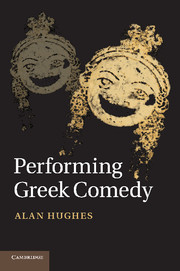Book contents
- Frontmatter
- Contents
- Illustrations
- Preface
- Chapter 1 Comedy in art, Athens and abroad
- Chapter 2 Poets of Old and Middle Comedy
- Chapter 3 Theatres
- Chapter 4 The comic chorus
- Chapter 5 Music in comedy
- Chapter 6 Acting, from lyric to dual consciousness
- Chapter 7 Technique and style of acting comedy
- Chapter 8 The masks of comedy
- Chapter 9 Costumes of Old and Middle Comedy
- Chapter 10 Comedy and women
- Chapter 11 New Comedy
- Catalogue of objects discussed
- Notes
- Glossary
- Bibliography
- Index
Chapter 3 - Theatres
Published online by Cambridge University Press: 05 February 2012
- Frontmatter
- Contents
- Illustrations
- Preface
- Chapter 1 Comedy in art, Athens and abroad
- Chapter 2 Poets of Old and Middle Comedy
- Chapter 3 Theatres
- Chapter 4 The comic chorus
- Chapter 5 Music in comedy
- Chapter 6 Acting, from lyric to dual consciousness
- Chapter 7 Technique and style of acting comedy
- Chapter 8 The masks of comedy
- Chapter 9 Costumes of Old and Middle Comedy
- Chapter 10 Comedy and women
- Chapter 11 New Comedy
- Catalogue of objects discussed
- Notes
- Glossary
- Bibliography
- Index
Summary
On a hot afternoon in 1968, a dusty road in the Peloponnesian back-country led me to a traditional Greek threshing-floor, circular and built into a hillside. Imagination populated the slope with a multitude draped in white linen, who watched the graceful dance of an Aischylean chorus: ‘Sing sorrow, sorrow; but good win out in the end.’ My fancy confirmed all I had read about the evolution of the Greek orchestra from just such a floor, and of the theatron (watching place) from a hollow hillside (koilon). It was thoroughly logical, plausible and seductive. Forty years later, the same account is repeated in handbooks and classrooms; but ‘Zeus, who guided men to think’ has also driven archaeologists to dig, and scholars to question received history, no matter how symmetrical. Subsequent research shows that the earliest Athenian orchestra was roughly rectilinear, and the earliest seating was composed of wooden grandstands erected upon level ground.
The Theatre of Dionysos in Athens may be neither the oldest nor the best preserved of Greek theatres, but none has been so thoroughly dug or exhaustively discussed. Much of the stone structure that visitors see is Roman in date, the last in an accumulation of alterations which have obliterated most traces of the fifth-century theatre, whose ‘meagre remains have been buried under an endless heap of commentaries’. At the risk of adding to the pile, this chapter will attempt a synthesis of contemporary interpretation; irreconcilable disputes are too numerous to permit consensus.
- Type
- Chapter
- Information
- Performing Greek Comedy , pp. 59 - 80Publisher: Cambridge University PressPrint publication year: 2011

